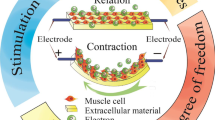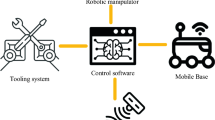Abstract
Binary actuators have only two discrete states, both of which are stable without feedback. As a result, manipulators with binary actuators have a finite number of states. The major benefits of binary actuation are that extensive feedback control is not required, reliability and task repeatability are very high, and two-state actuators are generally very inexpensive, resulting in low cost robotic mechanisms. These manipulators have great potential for use in both the manufacturing and service sectors, where the cost of high performance robotic manipulators is often difficult to justify. The most difficult challenge with a binary manipulator is to achieve relatively continuous end-effector trajectories given the discrete nature of binary actuation. Since the number of configurations attainable by binary manipulators grows exponentially in the number of actuated degrees of freedom, calculation of inverse kinematics by direct enumeration of joint states and calculation of forward kinematics is not feasible in the highly actuated case. This paper presents an efficient method for performing binary manipulator inverse kinematics and trajectory planning based on having the binary manipulator shape adhere closely to a time-varying curve. In this way the configuration of the arm does not exhibit drastic changes as the end effector follows a discrete trajectory.
Similar content being viewed by others
References
Canny, J. and Goldberg, K.: A RISC paradigm for industrial robotics, Technical Report ESRC 93-4/RAMP 93-2, Engineering Systems Research Center, University of California at Berkeley, 1993.
Chirikjian, G. S. and Burdick, J. W.: A modal approach to hyper-redundant manipulator kinematics, in: IEEE Trans. Robotics Automat., 1994, pp. 343–354.
Chirikjian, G. S. and Burdick, J. W.: Kinematically optimal hyper-redundant manipulator con-figurations, in: IEEE Trans. Robotics Automat., 1995, pp. 794–806.
Ewing, G. M.: Calculus of Variations With Applications, W. W. Norton and Co. Inc., NewYork, 1969.
Klein, C. A. and Huang, C. H.: Review of the pseudoinverse for control of kinematically redundant manipulators, IEEE Trans. Systems Man Cybernet. SMC-13(2) (1983), 245–250.
Koliskor, A. Sh.: The l-coordinate approach to the industrial robot design, in: 5th IFAC Symposium, Suzdal, USSR, April 22–25, 1986, pp. 108–115.
Maciejewski, A. A.: Fault tolerant properties of kinematically redundant manipulators, in: IEEE Conf. Robotics Automat., 1990, pp. 638–642.
Millman, R. S. and Parker, G. D.: Elements of Differential Geometry, Prentice-Hall, Englewood Cliffs, NJ, 1977.
Park, F. C.: Distance metrics on the rigid-body motions with applications to mechanism design, ASME J. Mech. Design 117(1995), 48–54.
Pieper, D. L.: The kinematics of manipulators under computer control, PhD Dissertation, Stanford University, 1968.
Roth, B., Rastegar, J., and Scheinman, V.: On the design of computer controlled manipulators, in: First CISM-IFTMM Symposium on Theory and Practice of Robots and Manipulators, 1973, pp. 93–113.
Salerno, R. J., Reinholtz, C. F., and Robertshaw, H. H.: Shape control of high degree-offreedom variable geometry trusses, in: Proceedings of the Workshop on Computational Aspects in the Control of Flexible Systems, Part 2, Williamsburg, VA, July 12–14, 1988.
Author information
Authors and Affiliations
Rights and permissions
About this article
Cite this article
Chirikjian, G.S. Inverse Kinematics of Binary Manipulators Using a Continuum Model. Journal of Intelligent and Robotic Systems 19, 5–22 (1997). https://doi.org/10.1023/A:1007942530293
Issue Date:
DOI: https://doi.org/10.1023/A:1007942530293




